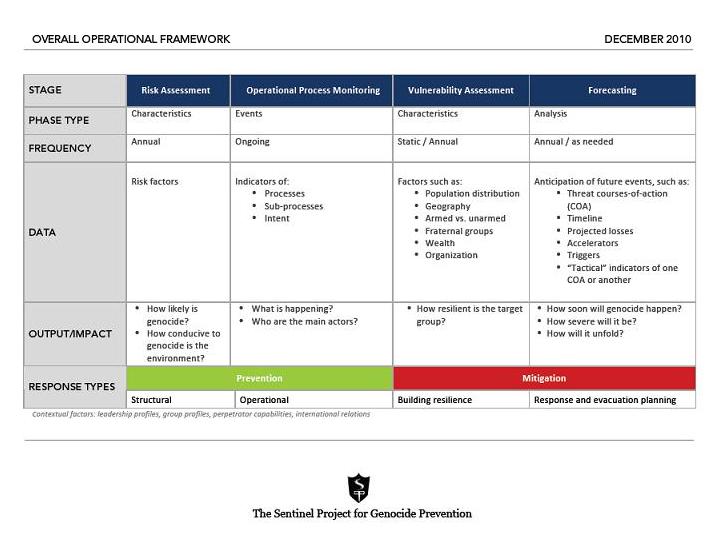As we announced in a recent blog post, the Research Team has been making progress on a list of risk factors that increase the likelihood of genocide taking place in a given country. While this is definitely a milestone in our development, it is really just one part of a much larger and more complex early warning process. To place the risk factor list in context, this post contains a brief explanation of how we envision the overall process working. The diagram below illustrates the framework under which we will work and show how our four phases of early warning fit together.

The Sentinel Project early warning system will be implemented in four phases.
The overall process will be continuous and subject to constant review, but the four phases represent different types of information gathering and analysis that take place within different time frames. Together, they form a transparent, repeatable process that will satisfy many of the information requirements for early warning and prevention. Here is how the four phases work:
1 – Risk Assessment – This is where the early warning process begins as analysts will examine many of the static characteristics which may predispose a country to genocide. The risk factor list will be used here during an annual global survey to help determine which countries require more engaged monitoring as a situation-of-concern (SOC). Information will largely be gathered from UN, NGO, governmental, and academic sources. In addition to our own internal use, warnings resulting from this phase will be shared with target groups and anti-genocide advocacy organizations. They may also help to inform structural prevention efforts.
2 – Operational Process Monitoring – Based on Gregory Stanton’s Eight Stages of Genocide model, this phase begins when a country is designated an SOC during the risk assessment phase. Conducted on an ongoing basis, information will be gathered from media and NGO reports, correspondents on the ground, and contacts with target communities themselves. This is one area where we will leverage social media and the creative use of technology. Information gathered this way will help to gauge how far the genocidal process has progressed, identify trends and patterns, who the main actors are, establish any genocidal intent and may inform operational prevention methods.
3 – Vulnerability Assessment – This phase is not yet fully elaborated, but its purpose is to examine the characteristics of the country and all the actors within an SOC to determine just how vulnerable to attack that the target group is. This phase begins the transition from prevention into the field of mitigation and will aid in building target group resilience in the event of the worst-case scenario.
4 – Forecasting – A very difficult process, this will be the most forward-looking phase in which an attempt is made to predict when genocidal violence may break out, how severe it is likely to be (building upon information from the vulnerability assessment), and what the most likely perpetrator courses-of-action are. This will inform intervention, response, and evacuation efforts.
As each of these phases is completed, its output will inform the overall process and ensure that the assessments and warnings resulting from each successive cycle are increasingly accurate. Building this system to its full potential effectiveness will, of course, take many years of hard work. During that time, we wish to keep our work open, transparent, and as collaborative as possible, so we welcome any questions, comments, and constructive feedback that you may have. Messages can be sent to the attention of the Research Team.
